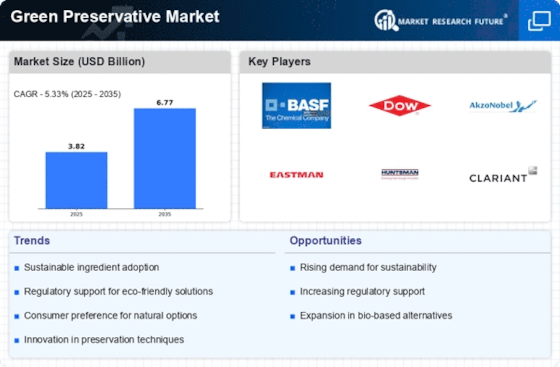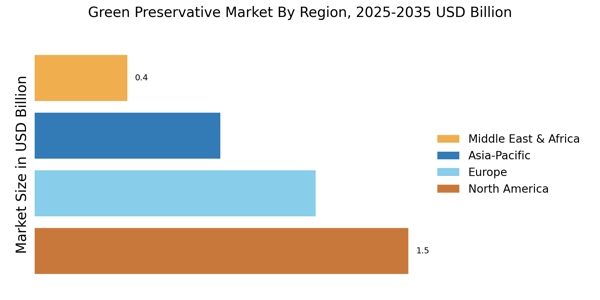Rising Consumer Awareness
The increasing awareness among consumers regarding the adverse effects of synthetic preservatives is driving the Green Preservative Market. As consumers become more informed about health and environmental issues, they are actively seeking products that contain natural and organic ingredients. This shift in consumer preference is evident in various sectors, including food, cosmetics, and pharmaceuticals. According to recent data, the demand for natural preservatives is projected to grow at a compound annual growth rate of 8.5% over the next five years. This trend indicates a significant opportunity for companies within the Green Preservative Market to innovate and expand their product offerings to meet consumer expectations.
Regulatory Support for Eco-Friendly Products
Regulatory bodies are increasingly implementing stringent guidelines that promote the use of eco-friendly products, which is beneficial for the Green Preservative Market. Governments are encouraging manufacturers to adopt sustainable practices, leading to a rise in the adoption of green preservatives. For instance, regulations that limit the use of harmful chemicals in food and personal care products are pushing companies to explore natural alternatives. This regulatory support not only enhances consumer safety but also fosters a competitive environment for businesses that prioritize sustainability. The Green Preservative Market is likely to see accelerated growth as compliance with these regulations becomes essential for market players.
Shift Towards Sustainable Packaging Solutions
The shift towards sustainable packaging solutions is influencing the Green Preservative Market significantly. As companies strive to reduce their environmental footprint, there is a growing emphasis on using biodegradable and recyclable materials. This trend is closely linked to the demand for green preservatives, as consumers are more likely to purchase products that align with their values regarding sustainability. The integration of green preservatives in products packaged sustainably enhances their appeal, potentially leading to increased sales. The Green Preservative Market stands to benefit from this synergy, as businesses that adopt both green preservatives and sustainable packaging are likely to capture a larger market share.
Technological Advancements in Preservation Methods
Technological advancements are playing a crucial role in shaping the Green Preservative Market. Innovations in extraction and formulation techniques are enabling the development of more effective natural preservatives. For example, advancements in biotechnology and nanotechnology are enhancing the efficacy and stability of green preservatives, making them viable alternatives to synthetic options. This evolution in preservation methods is expected to attract investments and research initiatives aimed at improving product performance. As a result, the Green Preservative Market is poised for growth, with companies leveraging these technologies to create superior products that meet consumer demands for safety and sustainability.
Increasing Demand from the Food and Beverage Sector
The food and beverage sector is experiencing a notable increase in demand for natural preservatives, which is a key driver for the Green Preservative Market. As consumers become more health-conscious, there is a marked shift away from artificial additives towards products that utilize natural ingredients. This trend is reflected in market data, which indicates that the natural food preservative segment is expected to grow at a rate of 7% annually. Companies in the Green Preservative Market are responding by reformulating their products to include natural preservatives, thereby catering to the evolving preferences of consumers. This demand from the food and beverage sector is likely to sustain the growth trajectory of the Green Preservative Market.


















Leave a Comment